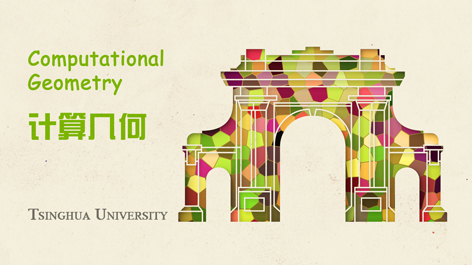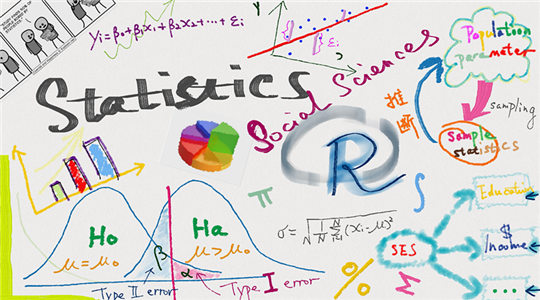
当前课程知识点:计算几何 > 05. Delaunay Triangulation > K. RIC Analysis > 05-K-05. Number Of Edge Changes
我们知道这件事
表面看起来是比较难
因为这件事毕竟已经发生了
而且我们并不在场
打个比喻
就像宇宙一样
我们知道宇宙刚刚诞生的时候
在刚开始的很短的一段时间内
具体发生了什么事
我们虽然现在已经知道了一些
但是我们毕竟还没有完全的知道
那么我们现在所知道的那些东西
是凭借什么来知道的呢
如果你具备一些物理知识的话
你应该知道
我们其实就是根据
宇宙现在还残存的一些信息
在当下还能捕捉到的一些信息
来反推出来的
比如说背景辐射
我们根据背景辐射
就可以倒推出很多东西来
在这里我们的背景辐射是什么呢
我们从头来说起
我们来看一下
这是我们当下的
已经插入完的一个格局
就像我们宇宙的现在当今一样
我们不知道
它是怎么演化过来的
因为如果我们没有更多的知识
任何一个点
包括这个G点在内
都有可能是最后一个被引入的点
所以最后一步到底花了多少时间
应该把所有的这些都统计出来
那么具体来说
假设其中这个G
如果它是作为最后一个点被插入
我们能够把它精确所需要的时间
准确的估计出来
这就足够了
这个方法如果能通用的话
就可以施加到
所有的点上去
所以我们不妨把目光
就考虑到其中的某一个点
或者是说
我们这个已经研究有速的
这个点就可以了
好 现在这个点就这个例子而言
它准确花费了多少次操作呢
你应该会想象的到
我们如果从增量的角度来看
它的操作其实就是一次一次的翻转
最主要的不过如此
而你不要忘了
在我们刚才的那个过程中
我们引入的那个概念叫做
frontier
没错 这个frontier在任何时候
都是以这个点为中心的
一个星形多边形
虽然它未必是
像这个例子那样巧是个凸的
但它至少是新型的
它有一个非空的核
其中G至少是一个点
那么每经过一次边的翻转
我们前面讲过
都会有一条老的边死掉
同时我们引入一条边
更重要的是
会有两条新的边
在完成了这次翻转之后
成为需要值得嫌疑待检查的边
我们需要对它们进行考核
所以frontier polygon
在每做过一次flip之后
它的size都会减1再加2
净增1个单位
这说明什么呢
这说明frontier polygon也就是这个
在任何时候
都忠实的记录了
在此前我们进行过多少次操作
更加巧合的是
我们会发现
如果我们记录上
最开始的那三次initial connection的话
这个数恰好能配平丝毫不差
比如刚才我们已经分析过
对这个例子而言
点G它所引起的edge change
恰好是5次
那么你可以注意到
这个时候最终的这个frontier polygon
它的size也恰好是5
最开始的时候是个3
有3条边
接下来每flip一次增加一次
flip两次所以增加两次
累计是5
所以你这里看出来了
我们这里所说的
对应于刚才说的宇宙的背景辐射
其实就是这个polygon
这个polygon最后的size是多少
就度量了我们在此前
如果G确实是最后一个点被插入的话
它花费了多少时间
好 这个还不足够用
我们在此还要往前迈进一步
我们刚才已经讲过
这个frontier polygon是一个star-shaped
是一个星形的多边形
所以它有多少条边
就有多少条边
与这个中心的kernel点G相连
而这个数值是多少呢
没错 恰好就是点G的度数
这是一个更加准确的
更加简明的
更加容易操作的
宇宙背景辐射
degree of point p
-Before we start
--html
-Evaluation
--html
-Online Judge
--html
-Lecture notes
--html
-Discussion
--html
-A. History of This Course
--00-A. History of This Course
-B. What's Computational Geometry
--00-B. What's Computational Geometry
-B. What's Computational Geometry--作业
-C. How to Learn CG Better
--00-C. How to Learn CG Better
-C. How to Learn CG Better--作业
-D. Why English
-A. Convexity
-A. Convexity--作业
-B. Extreme Points
-B. Extreme Points--作业
-C. Extreme Edges
-C. Extreme Edges--作业
-D. Incremental Construction
--01-D-01. Decrease and Conquer
--01-D-02. In-Convex-Polygon Test
--01-D-03. Why Not Binary Search
-D. Incremental Construction--作业
-E. Jarvis March
--01-E-06. Lowest-Then-Leftmost
-E. Jarvis March--作业
-F. Lower Bound
--01-F-02. CAO Chong's Methodology
-F. Lower Bound--作业
-G. Graham Scan: Algorithm
-G. Graham Scan: Algorithm--作业
-H. Graham Scan: Example
-H. Graham Scan: Example--作业
-I. Graham Scan: Correctness
-I. Graham Scan: Correctness--作业
-J. Graham Scan: Analysis
-J. Graham Scan: Analysis--作业
-K. Divide-And-Conquer (1)
-K. Divide-And-Conquer (1)--作业
-L. Divide-And-Conquer (2)
--01-L-03. Topmost + Bottommost ?
--01-L-07. More Considerations
-L. Divide-And-Conquer (2)--作业
-M. Wrap-Up
-0. Introduction
-0. Introduction--作业
-A. Preliminary
-A. Preliminary--作业
-B. Interval Intersection Detection
-B. Interval Intersection Detection--作业
-C. Segment Intersection Reporting
-C. Segment Intersection Reporting--作业
-D. BO Algorithm: Strategy
--02-D-01. Proximity & Separability
--02-D-02. Comparability & Ordering
-D. BO Algorithm: Strategy--作业
-E. BO Algorithm: Implementation
--02-E-03. Events & Operations
-E. BO Algorithm: Implementation--作业
-F. BO Algorithm: Analysis
--02-F-04. Complexity of Event Queue
--02-F-05. Complexity of Status Structure
-F. BO Algorithm: Analysis--作业
-G. Convex Polygon Intersection Detection
--02-G-01. Problem Specification
--02-G-02. Monotone Partitioning
--02-G-04. Decrease-And-Conquer
-G. Convex Polygon Intersection Detection--作业
-H. Edge Chasing
--02-H-01. Eliminating Sickles
-H. Edge Chasing--作业
-I. Plane Sweeping
-I. Plane Sweeping--作业
-J. Halfplane Intersection Construction
-J. Halfplane Intersection Construction--作业
-0. Methodology
-0. Methodology--作业
-A. Art Gallery Problem
--03-A-02. Lower & Upper Bounds
--03-A-04. Approximation & Classification
-A. Art Gallery Problem--作业
-B. Art Gallery Theorem
--03-B-01. Necessity of floor(n/3)
--03-B-02. Sufficiency by Fan Decomposition
-B. Art Gallery Theorem--作业
-C. Fisk's Proof
--03-C-04. Pigeon-Hole Principle
-C. Fisk's Proof--作业
-D. Orthogonal Polygons
--03-D-01. Necessity of floor(n/4)
--03-D-02. Sufficiency by Convex Quadrilateralization
-D. Orthogonal Polygons--作业
-E. Triangulation
-E. Triangulation--作业
-F. Triangulating Monotone Polygons
--03-F-02. Monotonicity Testing
--03-F-04. Stack-Chain Consistency
-F. Triangulating Monotone Polygons--作业
-G. Monotone Decomposition
-G. Monotone Decomposition--作业
-I. Tetrahedralization
--03-I-01. Polyhedron Decomposition
--03-I-02. Schonhardt's Polyhedron
-I. Tetrahedralization--作业
-A. Introduction
--04-A-02. Dining Halls on Campus
--04-A-03. More Analogies & Applications
-A. Introduction--作业
-B. Terminologies
--04-B-02. Intersecting Halfspaces
--04-B-04. Planar Voronoi Diagram
-B. Terminologies--作业
-C. Properties
--04-C-03. Nearest = Concyclic
--04-C-04. Number of Nearest Sites = Degree
-C. Properties--作业
-D. Complexity
-D. Complexity--作业
-E. Representation
-E. Representation--作业
-F. DCEL
-F. DCEL--作业
-G. Hardness
--04-G-03. Voronoi Diagram In General Position
-G. Hardness--作业
-H. Sorted Sets
--04-H-01. Convex Hull Made Easier
--04-H-02. Convex Hull As A Combinatorial Structure
--04-H-03. Voronoi Diagram As A Geometric Structure
-H. Sorted Sets--作业
-I. VD_sorted
--04-I-06. Sorting Not Made Easier
-I. VD_sorted--作业
-J. Naive Construction
-J. Naive Construction--作业
-K. Incremental Construction
-K. Incremental Construction--作业
-L. Divide-And-Conquer
--04-L-09. Intersecting with Cells
-L. Divide-And-Conquer--作业
-M. Plane-Sweep
--04-M-09. Circle Event: What, When & Where
-M. Plane-Sweep--作业
-A. Point Set Triangulation
-A. Point Set Triangulation--作业
-B. Delaunay Triangulation
-B. Delaunay Triangulation--作业
-C. Properties
-C. Properties--作业
-D. Proximity Graph
--05-D-02. Relative Neighborhood Graph
-D. Proximity Graph--作业
-E. Euclidean Minimum Spanning Tree
-E. Euclidean Minimum Spanning Tree--作业
-F. Euclidean Traveling Salesman Problem
-G. Minimum Weighted Triangulation
-G. Minimum Weighted Triangulation--作业
-H. Construction
--05-H-03. Maximizing The Minimum Angle
--05-H-04. Evolution By Edge Flipping
-H. Construction--作业
-I. RIC With Example
-I. RIC With Example--作业
-J. Randomized Incremental Construction
--05-J-01. Recursive Implementation
--05-J-02. Iterative Implementation
-J. Randomized Incremental Construction--作业
-K. RIC Analysis
--05-K-04. Types Of Edge Change
--05-K-05. Number Of Edge Changes
--05-K-07. Number Of Rebucketings
--05-K-08. Probability For Rebucketing
--05-K-10. Further Consideration
-0. Online/Offline Algorithms
--06-0. Online/Offline Algorithms
-0. Online/Offline Algorithms--作业
-A. Introduction
--06-A-03. Assumptions For Clarity
--06-A-05. Performance Measurements
-A. Introduction--作业
-B. Slab Method
--06-B-02. Ordering Trapezoids
-B. Slab Method--作业
-C. Persistence
--06-C-01. Ephemeral Structure
--06-C-02. Persistent Structure
-C. Persistence--作业
-D. Path Copying
--06-D-03. Storage Optimization
-D. Path Copying--作业
-E. Node Copying
-E. Node Copying--作业
-F. Limited Node Copying
-G. Kirkpatrick Structure
--06-G-01. Optimal And Simpler
--06-G-06. The More The Better
--06-G-07. The Fewer The Better
--06-G-09. Existence Of Independent Subset
--06-G-10. Construction Of Independent Subset
-G. Kirkpatrick Structure--作业
-H. Trapezoidal Map
--06-H-03. Properties & Complexity
--06-H-04. Search Structure: Example
--06-H-05. Search Structure: Nodes
--06-H-06. Search Structure: Performance
-H. Trapezoidal Map--作业
-I. Constructing Trapezoidal Map
--06-I-04. Case 1: Two Endpoints
--06-I-05. Case 2: One Endpoint
--06-I-06. Case 3: No Endpoints
-J. Performance Of Trapezoidal Map
--06-J-03. Number Of Ray Trimmed
--06-J-04. Number Of Trapezoidals Created (1)
--06-J-05. Number Of Trapezoidals Created (2)
--06-J-06. Time For Point Location
--06-J-07. Size Of Search Structure
--06-J-08. Fixed Query Point + Randomly Created Maps
--06-J-10. Probability Of Enclosing Trapezoid Changed
-A. Range Query
--07-A-01. 1-Dimensional Range Query
-A. Range Query--作业
-B. BBST
--07-B-02. Lowest Common Ancestor
-B. BBST--作业
-C. kd-Tree: Structure
-C. kd-Tree: Structure--作业
-D. kd-Tree: Algorithm
-D. kd-Tree: Algorithm--作业
-E. kd-Tree: Performance
--07-E-01. Preprocessing Time + Storage
-E. kd-Tree: Performance--作业
-F. Range Tree: Structure
--07-F-03. x-Query * y-Queries
-F. Range Tree: Structure--作业
-G. Range Tree: Query
-G. Range Tree: Query--作业
-H. Range Tree: Performance
-H. Range Tree: Performance--作业
-I. Range Tree: Optimization
--07-I-04. Fractional Cascading
-A. Orthogonal Windowing Query
-A. Orthogonal Windowing Query--作业
-B. Stabbing Query
-C. Interval Tree: Construction
-C. Interval Tree: Construction--作业
-D. Interval Tree: Query
-D. Interval Tree: Query--作业
-E. Stabbing With A Segment
--08-E-03. Query Algorithm (1)
--08-E-04. Query Algorithm (2)
-F. Grounded Range Query
--08-F-03. 1D-GRQ Using Range Tree
--08-F-04. 1D-GRQ By Linear Scan
-G. 1D-GRQ Using Heap
-G. 1D-GRQ Using Heap--作业
-H. Priority Search Tree
--08-H-03. Sibling Partitioning
-H. Priority Search Tree--作业
-I. 2D-GRQ Using PST
-I. 2D-GRQ Using PST--作业
-J. Segment Tree
--08-J-01. General Windowing Query
--08-J-02. Elementary Interval
--08-J-06. Solving Stabbing Query
--08-J-11. Constructing A Segment Tree
--08-J-12. Inserting A Segment (1)
--08-J-13. Inserting A Segment (2)
--08-J-14. Inserting A Segment (3)
-K. Vertical Segment Stabbing Query







